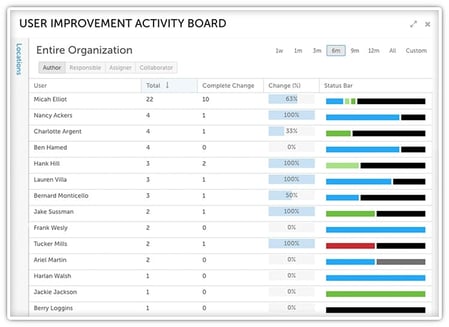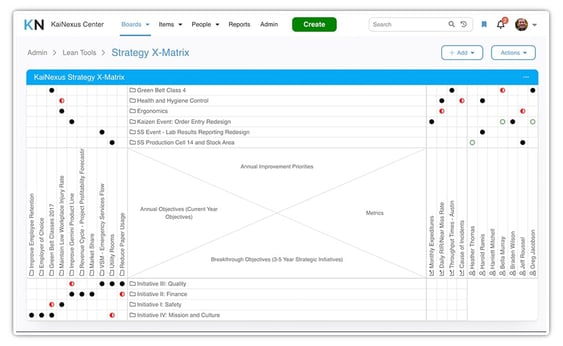 I like to think about Hoshin Kanri, also known as strategy deployment, as the ability of an organization to walk and chew gum at the same time. By that, I mean that organizations need to focus on strategic, long-term, breakthrough objectives while executing the day-to-day activities that keep the business running. Incremental process improvement needs to occur within the broader context of game changing transformation. That’s not easy.
I like to think about Hoshin Kanri, also known as strategy deployment, as the ability of an organization to walk and chew gum at the same time. By that, I mean that organizations need to focus on strategic, long-term, breakthrough objectives while executing the day-to-day activities that keep the business running. Incremental process improvement needs to occur within the broader context of game changing transformation. That’s not easy.
The practice of Hoshin Kanri arose when Japanese auto makers needed to do exactly that. Hoshin means "compass needle" or "direction," and Kanri means "management" or "control." It’s a brilliantly simple idea. Management needs to keep constant control over the direction in which the organization is moving. It is often described as defining and moving toward “true north.”
But how?
Here are the five guiding principles.
Communicated Objectives
 The first rule of Hoshin Kanri is everyone talks about Hoshin Kanri.
The first rule of Hoshin Kanri is everyone talks about Hoshin Kanri.
Leaders must clearly communicate what represents “true north” for the organization so that everyone can row in the same direction. This works best if the people who will be tasked with executing the strategy are involved in defining the goals and determine which metrics will be used to understand success.
Sharing the strategic objectives of the organization can’t be a one-time event. An annual announcement of the year’s goals is not sufficient to keep the organization on track. Reinforcement of the goals and status updates should be part of the regular cadence of communication. This is most easily achieved when there is technology in place that helps keep the long-term objectives front and center.
Current State Analysis
In order to understand what it will take to get where you are going, it is essential to know where you are. One of the first steps of Hoshin Kanri is getting deep insight into how the organization is functioning today, especially in relation to the key strategic objectives. Value stream mapping and Standard work are helpful tools for documenting the current state.
Widespread Engagement
 It is not possible to overstate the importance of Hoshin Kanri as a team sport. Everyone in the organization should have some stake in the outcome of strategic planning. Each individual’s goals should be in alignment with the organization’s overall objectives. They should clearly understand how their work propels the company toward true north.
It is not possible to overstate the importance of Hoshin Kanri as a team sport. Everyone in the organization should have some stake in the outcome of strategic planning. Each individual’s goals should be in alignment with the organization’s overall objectives. They should clearly understand how their work propels the company toward true north.
Widespread engagement is most easily accomplished within a culture of improvement. In a culture of improvement, employees are empowered, encouraged, and equipped to make small improvements that fuel the engine of Hoshin Kanri. They are recognized and rewarded for their ideas and engagement. Software that supports improvement work helps leaders understand who is actively involved in improvement activities and identify people who need more coaching and encouragement to get involved.
Prioritization of Resources
If everything is a priority, nothing is a priority. It’s a tough pill to swallow for many, but focusing on a few critical objectives means letting some things go. Most organizations could create a long list of opportunities for improvement. The organizations who are successful at Hoshin planning are able to identify which of those opportunities align to the strategic objectives and execute on them effectively. They are able to strike the right balance between what needs to be done to solve the problems of today and what must be done to create the future they’ve envisioned.
Performance Insight
 When we chat with leaders about how they are managing their strategic objectives, we often ask what indicators are used to judge the performance of the organization. In most cases, the answer is revenue. Revenue is an important measurement of course, but it alone is not enough to determine whether the organization is positioned to meet its long-term goals. Managing by that number alone would be like having a speedometer on your car’s dashboard but no indicator of how much gas you have.
When we chat with leaders about how they are managing their strategic objectives, we often ask what indicators are used to judge the performance of the organization. In most cases, the answer is revenue. Revenue is an important measurement of course, but it alone is not enough to determine whether the organization is positioned to meet its long-term goals. Managing by that number alone would be like having a speedometer on your car’s dashboard but no indicator of how much gas you have.
The practice of Hoshin Kanri requires insight into how the organization is progressing toward true north. Leaders should have a set of performance metrics that they can review at any time to track progress and intervene if there is friction or progress slows.
I said that Hoshin Kanri was like walking and chewing gum, but it’s obviously a lot more complicated than that. Dealing with everyday work and the problems that inevitably come up, while at the same time keeping your eye on the prize isn’t easy. But with the right technology and culture in place, it is achievable.
![[Watch Now] Cascading Strategy Through Hoshin Kanri](https://no-cache.hubspot.com/cta/default/326641/dd5ad176-fb74-4e1e-bf28-ff4d966d1701.png)



Add a Comment